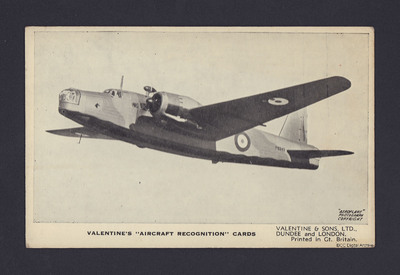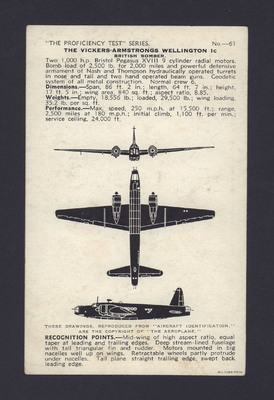Vickers Wellington 1c
Title
Vickers Wellington 1c
Description
An aircraft recognition card with a side photograph of a flying Wellington and on the reverse three silhouettes and technical details.
Creator
Language
Format
One double sided printed card
Publisher
Rights
This content is available under a CC BY-NC 4.0 International license (Creative Commons Attribution-NonCommercial 4.0). It has been published ‘as is’ and may contain inaccuracies or culturally inappropriate references that do not necessarily reflect the official policy or position of the University of Lincoln or the International Bomber Command Centre. For more information, visit https://creativecommons.org/licenses/by-nc/4.0/ and https://ibccdigitalarchive.lincoln.ac.uk/omeka/legal.
Contributor
Identifier
MDarbyCAH927893-180202-010011, MDarbyCAH927893-180202-010012
Transcription
[photograph]
VALENTINE’S “AIRCRAFT RECOGNITION” CARDS
VALENTINE & SONS, LTD.,
DUNDEE and LONDON.
Printed in Gt. Britain.
[page break]
“THE PROFICIENCY TEST” SERIES. No – 61
THE VICKERS-ARMSTRONGS WELLINGTON Ic
BRITISH BOMBER.
Two 1,000 h.p Bristol Pegasus XVIII 9 cylinder radial motors.
Bomb load of 2,500 lb. for 2,000 miles and powerful defensive armament of Nash and Thompson hydraulically operated turrets in nose and tail and two hand operated beam guns. Geodetic system of all metal construction. Normal crew 6.
Dimensions. – Span, 86 ft. 2 in.; length, 64 ft. 7 in.; height, 17 ft. 5 in.; wing area, 840 sq. ft.; aspect ratio, 8.85.
Weights. – Empty 18,556 Ib.; loaded, 29,500 lb.; wing loading, 35.2. lb per sq. ft.
Performance. – Max. speed, 205 m.p.h. at 15,500 ft.; range, 2,500 miles at 180 m.p.h.; initial climb, 1,100 ft. per min.; service ceiling, 24,000 ft.
[drawing]
[drawing]
[drawing]
THESE DRAWINGS, REPRODUCED FROM “AIRCRAFT IDENTIFICATION,” ARE THE COPYRIGHT OF “THE AEROPLANE.”
RECOGNITION POINTS. – Mid-wing of high aspect ratio, equal taper at leading and trailing edges. Deep stream-lined fuselage with tall triangular fin and rudder. Motors mounted in big nacelles well up on wings. Retractable wheels partly protrude under nacelles. Tail plane straight trailing edge, swept back leading edge.
VALENTINE’S “AIRCRAFT RECOGNITION” CARDS
VALENTINE & SONS, LTD.,
DUNDEE and LONDON.
Printed in Gt. Britain.
[page break]
“THE PROFICIENCY TEST” SERIES. No – 61
THE VICKERS-ARMSTRONGS WELLINGTON Ic
BRITISH BOMBER.
Two 1,000 h.p Bristol Pegasus XVIII 9 cylinder radial motors.
Bomb load of 2,500 lb. for 2,000 miles and powerful defensive armament of Nash and Thompson hydraulically operated turrets in nose and tail and two hand operated beam guns. Geodetic system of all metal construction. Normal crew 6.
Dimensions. – Span, 86 ft. 2 in.; length, 64 ft. 7 in.; height, 17 ft. 5 in.; wing area, 840 sq. ft.; aspect ratio, 8.85.
Weights. – Empty 18,556 Ib.; loaded, 29,500 lb.; wing loading, 35.2. lb per sq. ft.
Performance. – Max. speed, 205 m.p.h. at 15,500 ft.; range, 2,500 miles at 180 m.p.h.; initial climb, 1,100 ft. per min.; service ceiling, 24,000 ft.
[drawing]
[drawing]
[drawing]
THESE DRAWINGS, REPRODUCED FROM “AIRCRAFT IDENTIFICATION,” ARE THE COPYRIGHT OF “THE AEROPLANE.”
RECOGNITION POINTS. – Mid-wing of high aspect ratio, equal taper at leading and trailing edges. Deep stream-lined fuselage with tall triangular fin and rudder. Motors mounted in big nacelles well up on wings. Retractable wheels partly protrude under nacelles. Tail plane straight trailing edge, swept back leading edge.
Collection
Citation
Valentine & Sons, “Vickers Wellington 1c,” IBCC Digital Archive, accessed July 26, 2024, https://ibccdigitalarchive.lincoln.ac.uk/omeka/collections/document/39693.
Item Relations
This item has no relations.


